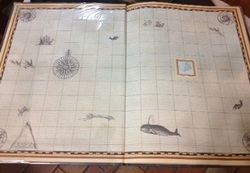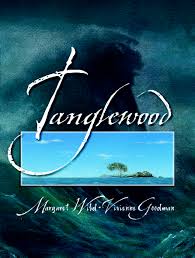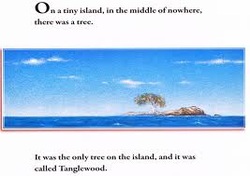Before Reading

Looking at the front cover:
What do you think 'Tanglewood' is?
How do you think this story is going to make you feel? What gives you this idea? Look at the colours that are used.
What might this story be about?
The two pictures on the front cover seem very different? How are they different? How could they be connected?
Now read the blurb on the back.
Does this change your views, about what this story might be about?
Look at the endpapers at the front of the book:
These are pictured above.
When the author and illustrator use this part of the book they are often adding further meaning to the story. For what purpose are the endpapers being used for this story?
What extra information can we gain from the endpapers before we start reading.
What do you think 'Tanglewood' is?
How do you think this story is going to make you feel? What gives you this idea? Look at the colours that are used.
What might this story be about?
The two pictures on the front cover seem very different? How are they different? How could they be connected?
Now read the blurb on the back.
Does this change your views, about what this story might be about?
Look at the endpapers at the front of the book:
These are pictured above.
When the author and illustrator use this part of the book they are often adding further meaning to the story. For what purpose are the endpapers being used for this story?
What extra information can we gain from the endpapers before we start reading.
Read the text

This story has a lot of deeper meaning and many messages from which we can learn. Read the story slowly. Ask the children to write on a piece of paper what they are thinking as you read the story. Any ideas they have gained or interesting meanings they find. Perhaps they might have questions.
Afterwards talk about the ideas and questions they have come up with.
Afterwards.....
What do you think the story is about?
How do the feelings of the tree change over time? Why do they change?
How does the illustrator represent the moods and emotions of the tree? When the tree is lonely what do the illustrations look like on the page? When the tree is feeling confident and at peace, how is the tree drawn and what colours are used?
After the storm, what symbols of hope and change are used in the illustrations?
Ask the children to think deeply about finishing this sentence:
This book is mainly a story about ________________________________. Go around the class and ask the children to share how they finished that sentence. Impress upon the children that there are no wrong answers as everyone is touched by this story in different ways.
After sharing, what were the common themes of the student's answers? Perhaps write these up on the easel.
Afterwards talk about the ideas and questions they have come up with.
Afterwards.....
What do you think the story is about?
How do the feelings of the tree change over time? Why do they change?
How does the illustrator represent the moods and emotions of the tree? When the tree is lonely what do the illustrations look like on the page? When the tree is feeling confident and at peace, how is the tree drawn and what colours are used?
After the storm, what symbols of hope and change are used in the illustrations?
Ask the children to think deeply about finishing this sentence:
This book is mainly a story about ________________________________. Go around the class and ask the children to share how they finished that sentence. Impress upon the children that there are no wrong answers as everyone is touched by this story in different ways.
After sharing, what were the common themes of the student's answers? Perhaps write these up on the easel.
Activity

Give out the cards to the students. The cards each have a statement about the book.
In their groups they are to discuss the question and whether or not they agree with it.
They are to give examples from the story where the statement is true.
They are also to discuss how they can see examples of this in their own lives.
Share their cards with the class and what ideas their group came up with in response to it.
In their groups they are to discuss the question and whether or not they agree with it.
They are to give examples from the story where the statement is true.
They are also to discuss how they can see examples of this in their own lives.
Share their cards with the class and what ideas their group came up with in response to it.
Use you booklet to respond to the story this week.